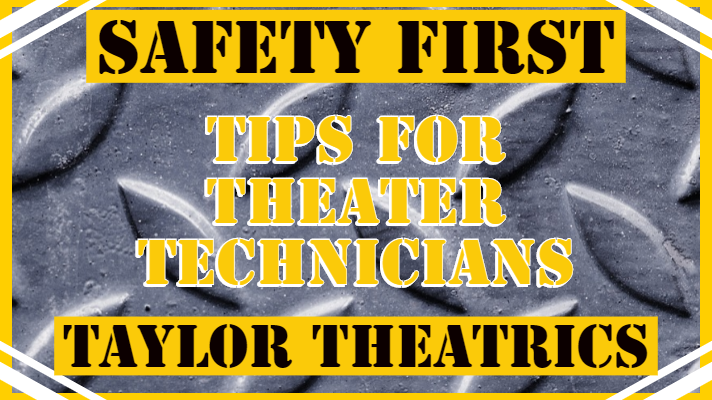Theater safety helps keep the technicians safe and ensure the future safety of actors and actresses who will be using the props and set that these technicians are creating. Here are several theater safety tips for theater technicians, specifically the set and prop crews.
1.Training
When prop making or working on a show set, in order to assure the safety of yourself and others, start by receiving qualified training if you feel unskilled with any particular tool. Find a master carpenter who has worked around this tool for a great portion of his or her life to train you on the safety features and use of the tool. Manuals and videos may be helpful, but face to face training is key.
2. Proper Clothing & Safety Equipment
Wearing the proper clothing and safety equipment is also important.
a. Shoes

 b. Knee Pads
b. Knee Pads
Knee pads are helpful when spending lots of time working on or near the floor. If you are working strictly on your knees, depending on your sense of balance, you can purchase knee pads with built in wheels. (Just be aware, that these can lead to additional fun that might reduce their safety factor.)
c. Eye Protection
Safety glasses help prevent dust particles or shards of metal or wood from getting into your eyes. When dealing with harsh chemicals that could potentially splash into your eyes, you’ll want secure fitting safety goggles.
d. Hearing Protection
Power tools can be loud and require hearing protection such as ear muffs or ear plugs. When not wearing hearing protection, avoid wearing headphones (or playing loud music) as this could cause you not to hear safety warnings being called out.
e. Gloves
Wear padded gloves when working rigging and leather gloves when cutting and shaping chicken wire. However, gloves should be avoided when using power tools.
2. Power Tools
 a. Drills
a. Drills
Drills may seem commonplace, however certain safety rules apply. For example, pull back long hair and avoid wearing dangling jewelry or clothing that might become entangled with the tool.
When purchasing drills, consider the weight. After repeated use, an 18 volt DeWalt drill can become cumbersome. The newer 20 volt drills are much smaller and lighter (life changing for anyone with arthritis). I wouldn’t recommend a corded drill because you will be limited by access to an outlet, not to mention that they tend to be way more powerful and the likelihood of stripping a screws goes up exponentially.
 c. Table Saws
c. Table Saws
Buying a table saw (whether for personal use or for the scene shop) is a big commitment, not just in terms of money, but especially where safety is concerned, and rightly so. SawStop states that “According to the Consumer Products Safety Commission, there is a table saw injury every 9 minutes, and 10 amputations every day in the United States. Even the most safety-conscious woodworkers are at risk of an accident. And when that accident happens, the consequences are life-changing: extreme pain and trauma, loss of income-earning abilities, and loss of the ability to pursue hobbies. It’s time to protect yourself.”

SawStop’s AIM (active injury mitigation) safety feature causes the blade to drop when coming in contact with skin. This happens within 5 milliseconds, thus preventing any actual injury. SawStop’s patent on this technology has
If you’re just starting out (or looking for something smaller and more portable than the Contractor or Professional models) I would go with the SawStop Jobsite Saw with Mobile Cart
3. Warning Signs
No matter where you are, part of staying safe means being aware of your surroundings. Slips, trips, and falls can be avoided by keeping walkways clear, but sometimes the hazard is the walkway itself. In cases such as this, light any hard to see walk ways (with aisle lights, for example) and marking other areas where the walkway may be uneven.

Other low lit, difficult to see areas can be marked using glow tape. This is a great solution for marking the edges of platforms, which can be difficult to see onstage in the dark between scene changes.
 4. Work Space Etiquette
4. Work Space Etiquette
a. Clean Work Space
Keeping a clean work space will not only make it easier to find what you need quickly; it will help remove the possibility of tripping over something or knocking something off that could fall on you or someone self. Avoid placing objects in walk ways or where people entering may be unaware of an obstacle. Also avoid placing objects on the top rungs of a ladder, as they could fall on you or someone else. Add warnings and/or padding to obstacles that can’t be removed.
b. Avoid Horse Play
While goofing around can be fun, being overly boisterous in a scene shop or while building onstage can be dangerous. For example, you do not want to accidentally pull the attention of someone who is trying to focus on using a cutting tool away from what they are doing. Being rambunctious in this area can cause yourself or others to fall or knock things over.
In Conclusion
Numerous tips and techniques in addition to the ones listed above exist for maintaining theater safety. There is no question that putting safety first is important for everyone, including the many dedicated theater technicians and actors who spend countless hours creating phenomenal live entertainment for audiences. By maintaining theater safety for technicians, you are further ensuring the safety of everyone who will come in contact with the set and props being built.












Safety should always be our top priority when doing something. Those are some great tips and are certainly helpful not only in theaters safety but also in other things.
I really think training is very important for theater technicians and safety instructions should be followed in all circumstances.